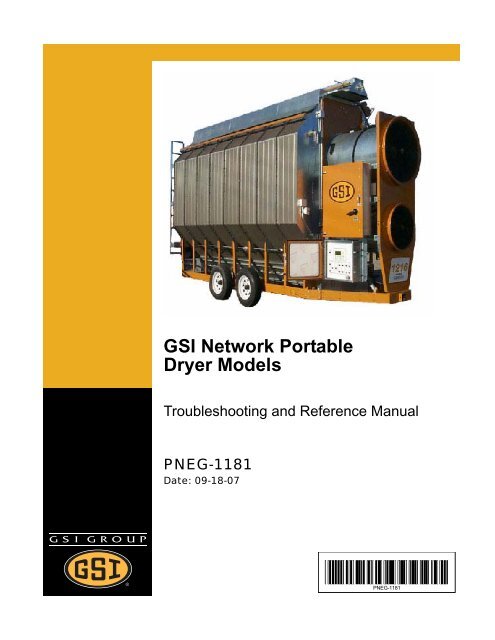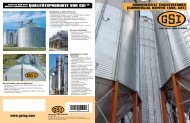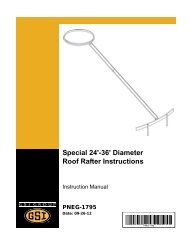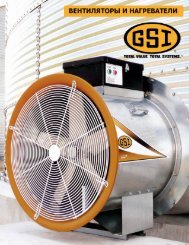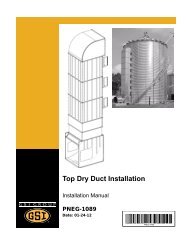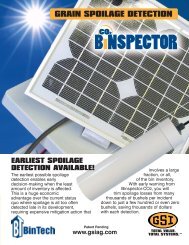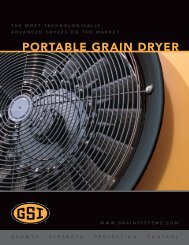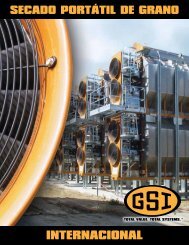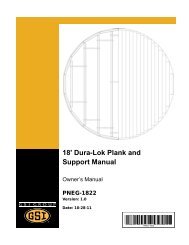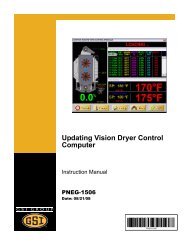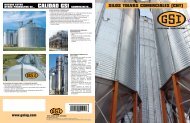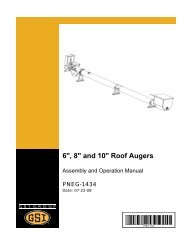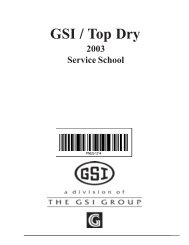PNEG-1181 - Network Portable Dryers - GRAIN SYSTEMS INC.
PNEG-1181 - Network Portable Dryers - GRAIN SYSTEMS INC.
PNEG-1181 - Network Portable Dryers - GRAIN SYSTEMS INC.
Create successful ePaper yourself
Turn your PDF publications into a flip-book with our unique Google optimized e-Paper software.
2 <strong>PNEG</strong>-<strong>1181</strong> <strong>Portable</strong> Dryer Troubleshooting
Table of ContentsChapter 9 Wiring Reference ............................................................................................................................. 312 Fan <strong>Network</strong> Dryer Internal Wiring ................................................................................................ 312 Fan <strong>Network</strong> Dryer Internal Jumper Wiring ................................................................................... 32Upper Control Back Panel Wiring .................................................................................................... 33<strong>Network</strong> Upper Control Panel Wiring (220 Volt 3PH) ....................................................................... 34<strong>Network</strong> Upper Control Panel Wiring (380, 460 and 575 Volt 3PH) ................................................. 352 Fan <strong>Network</strong> Power Circuit Diagram (220 Volt 1PH) (1 of 2) ........................................................ 36<strong>Network</strong> Power Circuit Diagram (220 Volt 1PH) (2 of 2) .................................................................. 372 Fan <strong>Network</strong> Power Circuit (220 Volt 3PH) (1 of 2) ...................................................................... 38<strong>Network</strong> Power Circuit (220 Volt 3PH) (2 of 2) ................................................................................. 392 Fan <strong>Network</strong> Power Circuit Diagram (440 Volt 3PH) (1 of 2) ........................................................ 40<strong>Network</strong> Power Circuit Diagram (440 Volt 3PH) (2 of 2) .................................................................. 41<strong>Network</strong> Control Circuit (Main Display Board) (1 of 4) ..................................................................... 42<strong>Network</strong> Control Circuit (Input/Output Board) (2 of 4) ...................................................................... 43<strong>Network</strong> Control Circuit (Meter Roll Sensor-SCR Board) (3 of 4) .................................................... 44<strong>Network</strong> Control Circuit (Fan/Heater Board) (4 of 4) ........................................................................ 45Upper Terminal Strip ........................................................................................................................ 46<strong>Network</strong> Upper Terminal Strip (With Moisture Manager Hookup/Relay) .......................................... 47Moisture Manager Hookup (<strong>Network</strong> or Competitor) ....................................................................... 48Input/Output Board Voltage Testing (Located in Upper Control Box) .............................................. 49Lower Control Box Back Panel Wiring ............................................................................................. 50<strong>Network</strong> Fan/Heater Interface (Located in Heater Control Box) ...................................................... 51<strong>Network</strong> Fan/Heater Computer Pinouts ........................................................................................... 52Fan/Can Control Box Wiring (Example: Single Phase Power) ......................................................... 53Lower Junction Box Wire Routing .................................................................................................... 54Upper Junction Box (Wiring) ............................................................................................................ 55<strong>Network</strong> Dryer Meter Roll Sensor Rearview (Wiring) ....................................................................... 56Testing Procedures and Location of Grain Temperature Sensors .................................................. 57Procedure for Locating, Testing and Replacing a Defective Grain Temperature Sensor ................ 58Sensor Chart .................................................................................................................................... 60Procedure for Locating, Testing and Replacing a Defective Plenum Temperature Sensor ............. 61Procedures for Replacing <strong>Network</strong> SCR Board ............................................................................... 63Chapter 10 Dryer Parts ..................................................................................................................................... 64Dryer Front Panel (Part Locations) ................................................................................................ 64Dryer Fan/Can Side View (Part Locations) .................................................................................... 65Plenum and Grain High Limit Locations ......................................................................................... 66Chapter 11 Air Switch Tip ................................................................................................................................ 67<strong>Network</strong> Series Air Switch Adjustment ........................................................................................... 67Chapter 12 SCR Board Setup .......................................................................................................................... 69SCR Board Terminals and Min./Max. Adjustment Locations ......................................................... 69Setting SCR Board Maximum Voltage ........................................................................................... 70Setting SCR Board Minimum Voltage ............................................................................................ 71Chapter 13 Cross Reference ............................................................................................................................ 72Overload Cross Reference Chart ................................................................................................... 72Motor Cross Reference Chart ........................................................................................................ 74Chapter 14 Warranty ......................................................................................................................................... 754 <strong>PNEG</strong>-<strong>1181</strong> <strong>Portable</strong> Dryer Troubleshooting
Safety PrecautionsREAD THESE INSTRUCTIONS BEFORE OPERATION AND SERVICESAVE FOR FUTURE REFERENCE1. Read and understand the operating manual before attempting to operate the dryer.1. Safety2. Power supply should be OFF for service of electrical components. Use CAUTION in checkingvoltage or other procedures requiring the power to be ON.3. Check for gas leaks at all gas pipe connections. If any leaks are detected, DO NOT operate thedryer. Shut down and repair before further operation.4. NEVER attempt to operate the dryer by jumping or otherwise bypassing any safety devices on the unit.5. Set pressure regulator to avoid excessive gas pressure applied to the burner during ignition andwhen the burner is in operation. DO NOT exceed maximum recommended drying temperature.6. Keep the dryer clean. DO NOT allow fine material to accumulate in the plenum or drying chamber.Clean grain is easier to dry. Fine material increases resistance to airflow and requires removal ofextra moisture.7. Use CAUTION in working around high speed fans, gas burners, augers and auxiliary conveyorswhich START AUTOMATICALLY.8. DO NOT operate in any area where combustible material will be drawn into the fan.9. BEFORE attempting to remove or reinstall any propeller, make sure to read the recommendedprocedure listed within the servicing chapter of the fan manual.This product is intended for the use of grain handling only. Any other use is considered a misuseof the product.Some edges of the product components can be sharp. Inspect each component to determinewhat specific safety considerations to be taken. Any and all necessary personal protectiveequipment should be worn at all times when handling, assembling, installing and operating theproduct and/or components.NOTE: Throughout this manual, guards are removed for illustration purposes only. All guards must bein place before and during operation.<strong>PNEG</strong>-<strong>1181</strong> <strong>Portable</strong> Dryer Troubleshooting 7
1. SafetyUse Caution in the Operation of this EquipmentThe design and manufacture of this dryer is targeted to maximize operator safety. However, graindryers have inherently hazardous components: a gas burner, high voltage electrical equipment, highspeed rotating parts, etc. It is not possible to fully safeguard against all hazards without impedingefficient operation and reasonable access to components. Therefore, a careful and knowledgeableowner/operator is the best insurance against an accident.Use extreme caution when working around high speed fans, gas-fired heaters, augers and auxiliaryconveyors, which may start without warning when the dryer is operating on automatic control.Keep the dryer clean. Not allow fine material to accumulate in the plenum chamberor surrounding the outside of the dryer.Continued safe, dependable operation of automatic equipment depends, to a great degree, upon theowner. For a safe and dependable drying system, follow the recommendations within the Owner’sManual, and make it a practice to regularly inspect the operation of the unit for any developing problemsor unsafe conditions.Take special note of all safety precautions before attempting to operate the dryer.8 <strong>PNEG</strong>-<strong>1181</strong> <strong>Portable</strong> Dryer Troubleshooting
2. DecalsRotating auger will crushand cut. Auto equipmentcan start at anytime. Do notenter until electric power islocked in off position. Failureto do so will result in seriousinjury or death.DC-974Moving parts can crushand cut. Keep handsclear. Do not operatewithout guards in place.Failure to do so couldresult in serious injury.DC-97210 <strong>PNEG</strong>-<strong>1181</strong> <strong>Portable</strong> Dryer Troubleshooting
3. Operation Tips<strong>Network</strong> Dryer Operation TipsImportant Software and Troubleshooting Tips (Software Version 1.08 and Up).Present Software Version Numbers: Display 1.19 Heater 1.19 Input/Output 1.181. Stuck register value. After installing a new display board and “flashing” the software in, an errormessage with “garbage” characters or a negative number for the temperature may appear. Tocorrect this, hard reboot the system by holding down the reset key and turning the power ON.Always perform a hard boot after installing a new Display board.2. If after a hard rebot the screen is still blank, the contrast may need to be adjusted. See tip #6 underGeneral Tips and Suggestions to adjust the contrast.3. When flashing new software to the Input/Output board, turn OFF the leveling auger breaker. Dueto design, the leveling auger will run whenever the Input/Output board is being flashed.4. If only the load and unload augers will not run check to make sure the 110 volt breaker on the Input/Output board is turned ON.5. The newest display boards (5/01/02) can now be used on either a Top Dry or <strong>Portable</strong> Dryer.In the past a dryer display board had to have wires soldered in place for the meter roll speedpotentiometer. The newest boards have a six pin connector that connects to the meter rollspeed potentiometer.6. The metering roll speed potentiometer connection at the potentiometer is correct when the visiblecopper on the connector is in the bottom.7. As dryers age, the contacts in the safeties start reducing the amount of DC voltage passed throughand may need to be replaced. Check the voltage if repeated error warnings are received from whatappears to be a good safety.General Tips and Suggestions1. In software version 1.19, the moisture control differential was reduced from 4° to 2°. As a result, thedryer will cycle quicker and control moisture better.2. In software version 1.18, the ability to calibrate bushels readings was added.3. In software version 1.17 and greater, holding down the UP and DOWN arrow keys while changingthe timer or delay setting will start changing the setting at a much faster rate.4. In version 1.17 and greater, pressing reset while changing a timer or delay setting will return thesetting to its default setting.5. To enter the switch and keypad test function for diagnostic purposes, press and hold the HELPbutton in. Turn ON the control power and release the HELP button. Turn any of the switches orpress any of the keypad buttons, and the one that you activated will be displayed on the screen.6. To enter the screen adjustment mode, press the SCREENS button while turning the control poweron. Use the UP and DOWN arrow keys to adjust the current level of contrast. NOTE: Continueddepression of the arrow keys (UP or DOWN) will not adjust the contrast. Instead, each press andrelease of the arrow keys (UP or DOWN) will adjust the contrast slightly. Because of this, adjustingthe contrast from a dark or blank screen to a visible screen will require many (100 or more) repeatedpresses of the arrow keys.<strong>PNEG</strong>-<strong>1181</strong> <strong>Portable</strong> Dryer Troubleshooting 11
3. Operation Tips<strong>Network</strong> Dryer Operation Tips (Continued)7. To return all options and settings to the factory defaults, press and hold the RESET button. Turnthe control power ON and release the RESET button. NOTE: ALL settings will be erased and alloptions will return to the factory defaults.8. To disable the air pressure switches, press and hold both the <strong>GRAIN</strong> and PLENUM buttons. TurnON the control power and release the buttons.9. To erase all shut downs in the computer history, press and hold both the DRY and COOL buttonsand turn ON the control power. Release the buttons.10. To view the shut down history of the dryer, press the UP and DOWN arrow buttons at the sametime, prior to pressing the START switch on the dryer. 256 dryer shut downs are stored in memory.Performing this keystroke sequence while changing a timer or a delay setting, will change thesetting to 0.01.11. Press the SCREENS button while the dryer is running to access the following data:A. Out of Grain - View “Out of Grain” TimerSet “Out of Grain” TimerCheck “Last Load” TimeB. View Grain TempsC. User Hour Meter (Hour meter can be reset here also).D. Meter Roll Speed Average. (Monitors the percentage of time the meter rolls spend on both highand low speed.)12. Press the SETUP button, before pressing start on the dryer in order to change the following settings:A. Enter the BPH factor (software version 1.18)B. Reset batch counterC. Clear total bushelsD. Change user message13. Press DELAYS button before pressing start on the dryer in order to access the following Delays:A. Load DelayB. Out of GrainC. Fan DelayD. Unload Clean Out Delay12 <strong>PNEG</strong>-<strong>1181</strong> <strong>Portable</strong> Dryer Troubleshooting
5. Dryer Operation<strong>Network</strong> Dryer Options ExplanationTurn Meter Rolls OFFThis option does not actually turn off the metering rolls. Changing this setting to YES removes thesensor board from the circuit and allows the dryer to operate normally, but without any meter rollinformation displayed on the screen. This is useful in the event of a sensor board failure. The sensorson the rear of the dryer and the computer monitor whether or not the metering rolls are turning when theUNLOAD is running. They also calculate the RPM, total bushels and Bushels Per Hour (BPH) of thegrain flowing across the meter rolls. If the meter rolls do not show movement in a two-minute period, thecomputer will shut down the dryer with a Meter Roll Drive System Failure. If, upon restarting the dryerthe meter rolls work properly, the drive system itself is okay and the problem is the sensor board itself.Run the dryer normally by switching this setting to YES. Replace the board as soon as possible andreturn this setting to ON when possible.Air Switch TestingSetting this option to NO allows the dryer to run without proving airflow. When a fan starts, it has20 seconds to develop air pressure in the plenum of the dryer. If pressure develops, the dryer operatesnormally. If no pressure develops, the dryer will shut down with a Loss of Airflow Shut Down errormessage. Changing this setting to NO allows the user to run the fan on the dryer if a switch becomesdefective. It also allows the user to run the fan on the dryer without grain inside of it. This option resetsevery time there is a dryer power loss of the dryer control power is shut OFF. Therefore, when restarted,the setting will default back to YES and require proof of airflow again. Change this option to NO to run thefan on the dryer without grain or with a defective switch until it is replaced.Meter Roll ReverseWhen set to YES, the meter rolls will run in the normal direction but, will occasionally slow to a stop andthen run in the reverse direction for a short period of time. The amount of time the meter rolls run inforward and in reverse is adjustable and programmable. This option will not be used regularly but isuseful when grain conditions are very poor.Select Unload MethodThe Select Unload Method is set to a default of 2 Speed. In this setting, meter rolls will speed up andslow down as needed to maintain constant grain moisture at the discharge of the dryer. While a3 Speed option is under development, it is not available on this software and this setting should, remainon 2 Speed.Select Dryer AddressMost owners will not use this setting as it requires the use of the GSI Watchdog software program tooperate. This option allows the user to assign an address for each dryer on the network to be monitoredby the Watchdog program. The system can monitor up to 10 dryers and log dryer functions wheneverany of the dryers are running.Attempt to RefillSetting this option to YES enables the dryer to monitor the Out of Grain Timer. When the dryer runs lowand the Out of Grain Timer runs down, the dryer will go into a “hold” mode instead of shutting down. Inthe “hold” mode, the unload auger shuts down, the burner turns off and the fan and the load augercontinue to run. If the dryer fills back up with grain, the burner will turn on again and the unload augerwill start up as well.14 <strong>PNEG</strong>-<strong>1181</strong> <strong>Portable</strong> Dryer Troubleshooting
Dyer Model Number5. Dryer OperationThis setting is critical to proper function of the dryer. The actual model number of the dryer is locatedhere and that number contains a great deal of valuable information about the dryer, including: numberof fans, number of modules, and the length of the dryer. This data is used by the computer to operatethe dryer properly. If any of this information is incorrect, the dryer will not operate properly and may notoperate at all. Use tremendous caution when changing this setting.Temperature ScaleThis option allows the user to toggle the temperature scale between Fahrenheit to Celsius.Change Burner Set-UpThis setting controls the operation of each fan/heater unit on the dryer. Users can run any burner, or anycombination of burners, on either High/Low Fire or On/OFF Fire. This setting also allows users to rendera problem fan/heater inactive, thereby removing it from the programming of the dryer and allowing theremainder of the dryer to continue running until the problem fan/heater can be repaired or replaced.Set Time and DateUse this setting to enter, store and adjust the time and date information.Select Load SystemWhile most dryers use the end fill option, GSI dryers also have the ability to run center fill and dual fillmodes if needed.Unit of MeasureThis setting allows the dryer to perform calculations in metric tons instead of bushels. This option isuseful for applications in foreign countries.Change Burner DifferentialThe burner differential is the number of degrees that a fan/heaters temperature must drop before it willcycle. Proper burner cycling means three (3) to four (4) times a minute the fan/heater should cycle fromhigh to low pressure. For this to happen, the burner must first reach the set point. The set point is thedesired running temperature for the plenum, usually around 220 degrees. When this temperature isreached, the burner will shut off one solenoid and divert all of the gas through the low pressure ballvalve and the low pressure solenoid. Turn down the low pressure ball valve far enough to allow thetemperature to start to fall. When the temperature falls the number of degrees set by the differential, theburner will cycle back to high. Keep in mind the burner should cycle three (3) to four (4) times a minute.<strong>PNEG</strong>-<strong>1181</strong> <strong>Portable</strong> Dryer Troubleshooting 15
6. ProgrammingProgramming Instructions Using Palm PilotThere are three (3) boards to program on the <strong>Network</strong> Dryer: Display Board (lower control box),Input/Output Board (upper control box), and Heater Interface Board (by Fan/Can housing).1. Turn the control power on the dryer to the OFF position.2. Locate the programming jack on each individual board:• Display Board (lower control panel) - (DB-9) located at bottom of board.• Input/Output Board (upper panel) - (DB-9) located at bottom of board.• Heater Interface Board (by fan/can housing) - (J2 connector) located on back of board.NOTE: Refer to See Figure 6A on Page 17.3. If programming the Input/Output Board or Display Board, connect the DB-9 connector from thePalm Pilot to the board.4. If programming the Heater Interface Board, connect the J2 connector on the series 2000 cable tothe J2 connector on the back of the board.5. Unplug the network connection (yellow and blue wires) to the board being programmed.6. On the Palm Pilot, select the program for that particular board and select it by “tapping” on it.7. Turn the dryer control power back ON.8. The programming process begins by erasing the present program and starting the new program.9. The screen will display a confirmation screen when the transfer of the software is complete.10. Turn the dryer control power OFF and remove the connector from the board. Plug the network wiresback into the board being programmed.11. Turn ON the dryer and the opening screens on the dryer will indicate the latest version of software.There are two Palm Pilot kits available from GSI for order:Ref # Part # DescriptionD03-0692 (Palm Flash Program Kit Deluxe)1 D01-1771 Series 2000 Programming Cable2 D03-0688 Palm Pilot IIIC (color)3 D03-0694 Palm Pilot Hot Sync Cable4 D03-0695 Palm Flash 9 Pin M-M Adapter5 D03-0709 Disk, CD-ROM Palm Flash SoftwareD03-0693 (Palm Flash Program Kit Economy)6 D01-1771 Series 2000 Programming Cable7 D03-0689 Palm Pilot M100 (black & white)8 D03-0695 Palm Flash 9 Pin M-M Adapter9 D03-0709 Disk, CD-ROM Palm Flash Software16 <strong>PNEG</strong>-<strong>1181</strong> <strong>Portable</strong> Dryer Troubleshooting
6. ProgrammingProgramming <strong>Network</strong> Dryer Using Palm PilotFigure 6A<strong>PNEG</strong>-<strong>1181</strong> <strong>Portable</strong> Dryer Troubleshooting 17
6. ProgrammingProgramming Instructions Using Flash ProgrammerThere are three (3) boards on the <strong>Network</strong> Dryer to program: Display Board (lower control box),Input/Output Board (upper control box), and the Heater Interface Board (Fan/Can housing).1. Turn the control power on the dryer to the OFF position.2. Locate the programming jack on each individual board:• Display Board (lower control panel) - (DB-9) located at bottom of board.• Input/Output Board (upper panel) - (DB-9) located at bottom of board.• Heater Interface Board (by fan/can housing) - (J2 connector) located on back of board.NOTE: Refer to See Figure 6B on Page 19.3. If programming the Input/Output Board or Display Board, connect the DB-9 connector from theFlash Programmer to the board.4. If programming the Heater Interface Board, connect the J2 connector on the series 2000 cable tothe J2 connector on the back of the board.5. Unplug the network connection (yellow and blue wires) to the board being programmed.6. Make sure the rotary switch on the programmer is set to position 8.7. Turn the dryer control power back ON.8. The four lights on the programmer will come ON, then three will go out leaving only the power lightstill illuminated.9. Push the Start button on the programmer to start the transfer of software.10. The Busy light will flash until the transfer process is complete.11. When completed, the Pass light will illuminate, indicating a successful transfer.12. After a successful transfer, turn control power OFF, remove connector from the board and plug thenetwork wires back into the board being programming.13. If the Fail light flashes, check the connection and repeat the above process.14. Turn ON the dryer and the opening screens of the dryer should indicate the latest version of software.18 <strong>PNEG</strong>-<strong>1181</strong> <strong>Portable</strong> Dryer Troubleshooting
Programming <strong>Network</strong> Dryer Using Flash Programmer6. ProgrammingFigure 6B*The Flash Programmer can still be used to program the dryer but the programmable chip for it is nolonger available. Therefore, GSI recommends using a Palm Pilot for programming.<strong>PNEG</strong>-<strong>1181</strong> <strong>Portable</strong> Dryer Troubleshooting 19
7. Board Hook UpProgrammer Hook Up Diagram(Located in Heater Control Box) (Back of Heater Board)Figure 7A20 <strong>PNEG</strong>-<strong>1181</strong> <strong>Portable</strong> Dryer Troubleshooting
7. Board Hook Up<strong>Network</strong> Display Board(Located in the lower control panel) (Back of Board)<strong>Network</strong>Terminal connections(blue and yellow wires)DB-9 ConnectorThis is used forprogramming the board.DB-9 ConnectorThis is used forWatchdog Program.Figure 7B<strong>PNEG</strong>-<strong>1181</strong> <strong>Portable</strong> Dryer Troubleshooting 21
7. Board Hook UpInput/Output Board(Located in Upper Control Panel)<strong>Network</strong>Terminal connections(blue and yellow wires)DB-9 ConnectorThis is used forprogramming the board.Figure 7C22 <strong>PNEG</strong>-<strong>1181</strong> <strong>Portable</strong> Dryer Troubleshooting
8. Troubleshooting TipsPossible Safety Circuit Shut Down MessagesViewing the Shut Down HistoryThe shut down history can store up to 200 shut down warnings. When the dryer exceeds this amount,the oldest shut down will be erased and replaced with the current shut down warning.To view the shut down history (Warnings):• Turn the Control Power to ON.• Wait until the time and date screen appears and then press the START button.• Press the increase and decrease buttons at the same time while the dryer is stopped. Then,scroll through the history by pressing either the increase or decrease buttons. Press enterto exit this screen or press stop to clear the shut down warning.Shut Down Message ListingThe following is a list of all possible shut down messages for the network dryer. They are broken downwith their associated controller where the error originated. The message on the screen will showWARNING at the top followed by the error, time, date and in which fan/heater the error occurred.FAN X LOSS OF AIRFLOWFan 1 Loss of Airflow: The contacts in the air switch have opened due to insufficient air pressure inthe plenum. The message will identify which plenum caused the shut down.HintsVerify that the fan is running and that the dryer is completely full of grain. If the air pressure switch issensing air pressure, the blue light in the fan switch will come on after the fan has reached half speed. Ifit does not, adjust the air switch using a straight blade screw driver to turn the adjusting screw on the airswitch counter-clockwise.This will make it more sensitive to air pressure. If this does not solve the problem,inspect the wiring circuit of the air pressure switch. Each air pressure switch is wired to the <strong>Network</strong>fan/heater Interface located on each individual fan/can box. Use a voltmeter on the following terminals:If all this fails to work, remove the wires from the air pressure switch and remove the switch from thedryer. Blow into the air tube to simulate air pressure in the plenum. The switch should have an opencircuit. Blow into the switch to close it. If it fails to close try adjusting it or replacing it.RememberBlack Probe (J7-10) DC NegativeRed Probe (J7-09) 0 VDC Fan Running Red Probe (J7-09) 5 VDC Fan StoppedRed Probe (J7-11) 5 VDC Fan Running Red Probe (J7-11) 0 VDC Fan StoppedIf operating correctly, the voltmeter should display the reading listed above.Any other reading may indicate a bad switch, computer board, air pressureswitch or wiring.1. Dryer must be full of grain. (Make sure fill is keeping up with unload.)2. Check to see if light comes ON when fan is running.3. Make sure the bulb is good. It is a 110 VAC.<strong>PNEG</strong>-<strong>1181</strong> <strong>Portable</strong> Dryer Troubleshooting 23
8. Troubleshooting TipsPossible Safety Circuit Shut Down Messages (Continued)VAPOR X HIGH LIMITVapor 1 High Limit: The LP gas vapor temperature sensor, located in the gas pipe train downstream fromthe vaporizer, has opened indicating that the vaporizer is running too hot and must be adjusted. This sensoris set at 200°F and will automatically reset itself when cool. Adjust the vaporizer coil away from the burnerflame. Make sure the LP tank has fuel in it. Also, try switching to ON/OFF cycle rather than High/Low,especially on warmer days. If the error still does not clear after pushing the stop button, check the fan/heaterinterface. The error message shows on which heater this condition occurred.Use a voltmeter on the following terminals:Black probe (J7-10) DC negativeRed probe (J7-16) 12 VDC outputRed probe (J7-01) 12 VDC when closed<strong>GRAIN</strong> TEMP OPEN XGrain Temp Open 1: This error indicates there is a open condition with one of the grain temperaturesensors located inside the left or right grain columns. This could be a open sensor or the sensor wirescould be disconnected. These sensors are wired to a fan/heater interface, which one depends on themodel of dryer. Refer to the Dryer Front Panel Parts Location Wiring for location of the actual sensors.The terminals they are wired to are as follows:Grain Temp Sensor Ground - (J7-18)Grain Temp Sensor - (J7-14)When testing these sensors to see if they are bad refer Temperature Chart (Series 2000 Temp Sensors)on Page 60 and also Grain Sensor Testing on Page 57.<strong>GRAIN</strong> TEMP SHORT XGrain Temp Short 1: This error indicates a shorted condition with one of the grain temperaturesensors located inside the left or right grain columns. This could be a shorted sensor or the sensor wirescould be shorted together. The sensors are wired to a fan/heater interface. Refer to the Dryer FrontPanel Parts Location Wiring more complete information.The terminals they are wired to are as follows:Grain Temp Sensor Ground - (J7-18)Grain Temp Sensor - (J7-14)When testing these sensors to see if they are bad, refer to the Temperature Chart (Series 2000 TempSensors) on Page 60 and also Grain Sensor Testing on Page 57.PLENUM TEMP OPEN XPlenum Temp Open 1: This error indicates an open condition with the plenum temperature sensorlocated inside the plenum chamber. This could be an open sensor or the sensor wires could bedisconnected. These sensors are wired to a fan/heater interface, which one depends on number ofplenums. The error message will show in which plenum the opening occurred. Refer to the Dryer FrontPanel Parts Location Wiring for location of the actual sensors. The terminals they are wired to are asfollows:Plenum Temp Sensor Ground - (J7-13)Plenum Temp Sensor - (J7-12)<strong>PNEG</strong>-<strong>1181</strong> <strong>Portable</strong> Dryer Troubleshooting 25
8. Troubleshooting TipsPossible Safety Circuit Shut Down Messages (Continued)PLENUM TEMP SHORT XPlenum Temp Short 1: This error indicates a shorted condition with the plenum temperature sensorlocated inside the plenum chamber. This could be a short in the sensor or the sensor wires. Thesesensors are wired to a fan/heater interface, which sensor contains the short depends on number ofplenums. The error message will show in which plenum the short occurred. Refer Dryer Front PanelParts Location Wiring for location of the actual sensors.The terminals they are wired to are as follows:Plenum Temp Sensor Ground - (J7-13)Plenum Temp Sensor - (J7-12)FLAME LOSS XFlame Loss 1: This error indicates that the flame probe has failed to detect a burner flame that had alreadybeen established. This may be caused by the flame probe not being directly in the flame path, loss of fuel, ora problem with the burner circuit. Sometimes, the loss of flame occurs when the burner cycles to Low Fire. Tocorrect this error, adjust the gas pressure or adjust the flame probe to where it is in the flame path at all times.Make sure power is OFF while adjusting the gas pressure or flame probe tocorrect the Flame Loss error.Remove the access door on the side of the fan/heater housing to allow access to the flame probe.Another way to see if the burner is sensing flame correctly is to watch the light in the burner switch. If itstarts to flicker, an adjustment may need to be made on the flame probe. The flame probe wire andground wire are connected to the fan/heater interface. The error message will show in which heater theflame loss has occurred.The terminals they are wired to are as follows:Flame Probe Ground - (J7-20)Flame Probe Wire - (J7-19)IGNITION FAILURE XIgnition Failure 1: This happens when the burner fails to light. Make sure the fuel source has beenturned ON, all valves are ON, especially the Maxon valve. The Maxon valve has to be reset every timean error occurs or there is a loss of power. Check the wiring, igniter gap (which needs to be about 1/8")and make sure there is a spark. The igniter is located inside the fan/heater housing and the wiringfrom it goes directly to the ignition transformer, which is located in the fan/can box on the outside of thefan/heater housing. Access the igniter by removing the access door on the side of the fan/heater housingor entering through the rear door of the dryer.Make sure power is OFF while adjusting the igniter.Power to the ignition transformer is received from the fan/heater interface. The error message will showin which heater the ignition failure has occurred.The terminals the ignition transformer are wired to are as follows:Transformer Ground - (J6-02) AC NeutralTransformer Power - (J6-06) AC Power 120 VAC26 <strong>PNEG</strong>-<strong>1181</strong> <strong>Portable</strong> Dryer Troubleshooting
8. Troubleshooting TipsPossible Safety Circuit Shut Down Messages (Continued)ILLEGAL FLAME XIllegal Flame 1: This message is displayed when the flame detection circuit of the heater senses flamewhen the burner is supposed to be OFF. Example, after being shut down, the dryer and the heatercontinue to burn due to a solenoid stuck open. The error message will show in which heater the illegal flamehas occurred.MOTOR OVERLOAD XMotor Overload 1: This indicates that one of the fan motor thermal overloads has opened. Thisoverload is located in the fan/can box on the side of the fan/heater housing. The overload must bemanually reset by pushing the red button. The message will display in which fan the overload hasoccurred. If the error does not clear after resetting the overload and pushing the stop button. You mighthave to check in the fan/heater interface located nearest that same fan/can. The overload is connectedto the fan/heater interface. This is the only overload that is located here, the rest are located in the uppermain panel. Refer to the Motor Overload below for more motor overload information.Use a voltmeter on the following terminals:Black Probe (J7-10) DC negativeRed Probe (J7-15) 12 VDC outputRed Probe (J7-04) 12 VDC when closedInput/Output ErrorsThe following is a list of errors that are generated with the Input/Output board. This board is located inthe upper control box of your <strong>Network</strong> Dryer.Motor OverloadThe following are messages that may show up under this shut down. These overloads are located in theupper panel. This means that the thermal overload has opened on the motor indicated on the display.The overload has to be manually reset by pushing the red button on the overload. This indicates thatthis motor might be operating under an abnormal work load. This condition causes the motor to pull morecurrent (ampere) over its rated full load ampere. It may be necessary to have an electrician to check themotors operating amperage. The name tag on the motor will indicate the full load ampere (FLA) inrelationship with the incoming voltage. The overload has a normally closed set of contacts. To thesecontacts from the Input/Output board is sent 12 VDC, when the overload opens so do these contacts.Below will indicate which terminals to check for that particular overload shut down. When checking DCvoltage you must have a DC negative. The DC negative is located on the Input/Output board where thenetwork connections are terminated. It is a three terminal block connection, use the unused terminal forthe DC negative. Refer Input/Output Board Voltage Testing Wiring.LOAD MOTOR OVERLOADUse a voltmeter on the following terminals:Black probe-unused terminal where the network connections are terminated (Input/Output Board)Red probe (J3-09) 12 VDC outputRed probe (J2-11) 12 VDC when closed<strong>PNEG</strong>-<strong>1181</strong> <strong>Portable</strong> Dryer Troubleshooting 27
8. Troubleshooting TipsPossible Safety Circuit Shut Down Messages (Continued)AUX LOAD OVERLOADUse a voltmeter on the following terminals:Black probe - unused terminal where the network connections are terminated (Input/Output Board)Red probe (J3-09) 12 VDC outputRed probe (J2-10) 12 VDC when closedUNLOAD MOTOR OVERLOADUse a voltmeter on the following terminals:Black probe - unused terminal where the network connections are terminated (Input/Output Board)Red probe (J3-09) 12 VDC outputRed probe (J2-09) 12 VDC when closedAUX UNLOAD MOTOR OVERLOADUse a voltmeter on the following terminals:Black probe - unused terminal where the network connections are terminated (Input/Output Board)Red probe (J3-09) 12 VDC outputRed probe (J2-12) 12 VDC when closedREAR DISCHARGEThis indicates that the lid on the grain discharge box has opened. This could be caused by the grain notbeing taken away fast enough or not at all. Checking the grain take away system will usually fix thisproblem. There is 12 VDC sent out from the Input/Output board to the mercury switch located under thedischarge box lid and must return to the board or this error will appear.Use a voltmeter on the following terminals:Black probe - unused terminal where the network connections are terminated (Input/Output Board)Red probe (J3-07) 12 VDC outputRed probe (J2-05) 12 VDC when closedUSER SAFETYA shut down has occurred due to a user installed safety switch that has opened. The connections to thisare on the terminal strip located in the upper panel. There is 12 VDC sent out and must return or thiserror will appear. This input is normally jumpered when it leaves the factory on the terminal strip. If in usethis has normally been installed by an electrician.Use a voltmeter on the following terminals:Black probe - unused terminal where the network connections are terminated (Input/Output Board)Red probe (J3-07) 12 VDC outputRed probe (J2-01) 12 VDC when closed28 <strong>PNEG</strong>-<strong>1181</strong> <strong>Portable</strong> Dryer Troubleshooting
8. Troubleshooting TipsPossible Safety Circuit Shut Down Messages (Continued)METER ROLLS FAILEDThis is usually caused by either a defective meter roll sensor or the meter rolls not turning because of abroken drive chain, jammed meter roll, bad motor or gear case. The meter roll sensor is located in awhite plastic box on the rear of the dryer. The box is mounted on the end of the meter roll drive shaft.12 VDC is sent out to the meter roll sensor, which in turn sends a pulse signal back to the terminal stripin the upper panel. (The meter rolls must be turning in order for the pulse signal to return). After checkingto make sure the meter rolls are turning, the following may need to be checked.Refer to the <strong>Network</strong> Dryer Meter Roll Sensor Rearview Wiring in the manual.Use a voltmeter on the following terminals:Black probe - (J3-04) 12 VDC negativeRed probe (J3-07) 12 VDC outputRed probe (J3-03) meter roll return (If you are not able to read a pulse signal with your meter. Set yourmeter to read DC voltage and you should be able to read a varying DC voltage. Some where between0 VDC and 12 VDC).OUT OF <strong>GRAIN</strong>The Out of Grain Timer has timed out. A mercury switch located on top of the dryer in a white plastic boxresets the timer. It is connected to a paddle that is moved by grain as the dryer fills. Shut down usuallyoccurs when the loading equipment has difficulty keeping up with the dryer output or when the wetsupply has run out of grain. The length of time set for the timer can be increased, however, the tophopper of the dryer should always have grain in it. If the side screens open up at anytime, the dryer islosing heat as well as efficiency. Therefore, the fill equipment must be big enough to handle the capacityof the dryer. Also, keep in mind that the Out of Grain Timer is only in operation when the load switch isin the AUTO position.Black probe - unused terminal where the network connections are terminated (Input/Output Board)Red probe (J3-07) 12 VDC outputRed probe (J2-01) 12 VDC when the dryer is calling for grainRed probe (J2-01) 0 VDC when the dryer is fullMaster Display Generated ErrorsThe following is a list of errors that come from the Master Display Board located in the lower control box.CONT-BATCH MODE CHNGThis error occurs when switching the dryer mode switch from the Continuous Flow to the Staged Batchmode while the dryer is running. To avoid this shut down, stop the dryer before switching modes. Pressthe stop button to clear.NETWORK FAILED: FH1This error is generated when a fan/heater board (near the fan/can housing) loses its communication linkwith the Input/Output board (on the upper control panel) and the Master Display Board (on the lowercontrol panel). Check the blue and yellow wires marked N1-01 and N1-02 on a three (3) terminal plugto make sure they are plugged in tightly. Also check and make sure the blue and yellow wires havecontinuity between each other (blue to blue and yellow to yellow). The error message displayed will showwhich fan/heater has lost communication. Example FH1-FH2-FH3 etc. Press STOP to clear.<strong>PNEG</strong>-<strong>1181</strong> <strong>Portable</strong> Dryer Troubleshooting 29
8. Troubleshooting TipsPossible Safety Circuit Shut Down Messages (Continued)NETWORK FAILED: Input/OutputThis error occurs when the Input/Output Board (upper control panel) has lost its communications linkwith the Master Display Board (lower control panel) and the fan/heater Boards. Check the blue andyellow wires marked N1-01 and N1-02 on a three (3) terminal plug to make sure they are plugged intightly. Check and make sure the blue and yellow wires have continuity between each other (blue to blueand yellow to yellow). There are three (3) LED lights next to the three (3) terminal plug, one is for powerand the others indicate data being transmitted between the boards. The two labeled RXD and TXDshould be flashing randomly back and forth, this indicates network activity. Press stop to clear.NETWORK FAILED: MASTThis error occurs when the Master Display Board (lower control panel) has lost its communicationslink with the Input/Output Board (upper control panel) and the fan/heater Boards. Check the blue andyellow wires marked N1-01 and N1-02 on a three (3) terminal plug to make sure they are plugged intightly. Also check and make sure the blue and yellow wires have continuity between each other(blue to blue and yellow to yellow). Press stop to clear.30 <strong>PNEG</strong>-<strong>1181</strong> <strong>Portable</strong> Dryer Troubleshooting
9. Wiring Reference2 Fan <strong>Network</strong> Dryer Internal Wiring(Back of Control Panel Switches to Display Board)<strong>PNEG</strong>-<strong>1181</strong> <strong>Portable</strong> Dryer Troubleshooting 31
9. Wiring Reference2 Fan <strong>Network</strong> Dryer Internal Jumper Wiring32 <strong>PNEG</strong>-<strong>1181</strong> <strong>Portable</strong> Dryer Troubleshooting
9. Wiring ReferenceUpper Control Back Panel Wiring<strong>PNEG</strong>-<strong>1181</strong> <strong>Portable</strong> Dryer Troubleshooting 33
9. Wiring Reference<strong>Network</strong> Upper Control Panel Wiring (220 Volt 3PH)34 <strong>PNEG</strong>-<strong>1181</strong> <strong>Portable</strong> Dryer Troubleshooting
9. Wiring Reference<strong>Network</strong> Upper Control Panel Wiring (380, 460 and 575 Volt 3PH)<strong>PNEG</strong>-<strong>1181</strong> <strong>Portable</strong> Dryer Troubleshooting 35
9. Wiring Reference2 Fan <strong>Network</strong> Power Circuit Diagram (220 Volt 1PH) (1 of 2)36 <strong>PNEG</strong>-<strong>1181</strong> <strong>Portable</strong> Dryer Troubleshooting
<strong>Network</strong> Power Circuit Diagram (220 Volt 1PH) (2 of 2)9. Wiring Reference<strong>PNEG</strong>-<strong>1181</strong> <strong>Portable</strong> Dryer Troubleshooting 37
9. Wiring Reference2 Fan <strong>Network</strong> Power Circuit (220 Volt 3PH) (1 of 2)38 <strong>PNEG</strong>-<strong>1181</strong> <strong>Portable</strong> Dryer Troubleshooting
9. Wiring Reference<strong>Network</strong> Power Circuit (220 Volt 3PH) (2 of 2)<strong>PNEG</strong>-<strong>1181</strong> <strong>Portable</strong> Dryer Troubleshooting 39
9. Wiring Reference2 Fan <strong>Network</strong> Power Circuit Diagram (440 Volt 3PH) (1 of 2)40 <strong>PNEG</strong>-<strong>1181</strong> <strong>Portable</strong> Dryer Troubleshooting
<strong>Network</strong> Power Circuit Diagram (440 Volt 3PH) (2 of 2)9. Wiring Reference<strong>PNEG</strong>-<strong>1181</strong> <strong>Portable</strong> Dryer Troubleshooting 41
9. Wiring Reference<strong>Network</strong> Control Circuit (Main Display Board) (1 of 4)42 <strong>PNEG</strong>-<strong>1181</strong> <strong>Portable</strong> Dryer Troubleshooting
<strong>Network</strong> Control Circuit (Input/Output Board) (2 of 4)9. Wiring Reference<strong>PNEG</strong>-<strong>1181</strong> <strong>Portable</strong> Dryer Troubleshooting 43
9. Wiring Reference<strong>Network</strong> Control Circuit (Meter Roll Sensor-SCR Board) (3 of 4)44 <strong>PNEG</strong>-<strong>1181</strong> <strong>Portable</strong> Dryer Troubleshooting
<strong>Network</strong> Control Circuit (Fan/Heater Board) (4 of 4)9. Wiring Reference<strong>PNEG</strong>-<strong>1181</strong> <strong>Portable</strong> Dryer Troubleshooting 45
9. Wiring Reference<strong>Network</strong> Upper Terminal Strip (With Moisture Manager Hookup/Relay)<strong>PNEG</strong>-<strong>1181</strong> <strong>Portable</strong> Dryer Troubleshooting 47
9. Wiring ReferenceMoisture Manager Hookup (<strong>Network</strong> or Competitor)48 <strong>PNEG</strong>-<strong>1181</strong> <strong>Portable</strong> Dryer Troubleshooting
9. Wiring ReferenceInput/Output Board Voltage Testing (Located in Upper Control Box)<strong>PNEG</strong>-<strong>1181</strong> <strong>Portable</strong> Dryer Troubleshooting 49
9. Wiring ReferenceLower Control Box Back Panel Wiring50 <strong>PNEG</strong>-<strong>1181</strong> <strong>Portable</strong> Dryer Troubleshooting
9. Wiring Reference<strong>Network</strong> Fan/Heater Interface (Located in Heater Control Box)<strong>PNEG</strong>-<strong>1181</strong> <strong>Portable</strong> Dryer Troubleshooting 51
9. Wiring Reference<strong>Network</strong> Fan/Heater Computer Pinouts52 <strong>PNEG</strong>-<strong>1181</strong> <strong>Portable</strong> Dryer Troubleshooting
9. Wiring ReferenceFan/Can Control Box Wiring (Example: Single Phase Power)<strong>PNEG</strong>-<strong>1181</strong> <strong>Portable</strong> Dryer Troubleshooting 53
9. Wiring ReferenceLower Junction Box Wire Routing54 <strong>PNEG</strong>-<strong>1181</strong> <strong>Portable</strong> Dryer Troubleshooting
9. Wiring ReferenceUpper Junction Box (Wiring)<strong>PNEG</strong>-<strong>1181</strong> <strong>Portable</strong> Dryer Troubleshooting 55
9. Wiring Reference<strong>Network</strong> Dryer Meter Roll Sensor Rearview (Wiring)56 <strong>PNEG</strong>-<strong>1181</strong> <strong>Portable</strong> Dryer Troubleshooting
9. Wiring ReferenceTesting Procedures and Location of Grain Temperature SensorsThe grain sensors terminate at the Heater Board located by the fan/can housing. Single module with twofans, grain sensors are wired to bottom heater board. On a stack dryer with multiple fan/heaters, thesensors will be terminated on the bottom Heater Board of the second module. It does not matter if thesecond module has one fan/heater or two fan/heaters. If a bad sensor is suspected, always check theheater board first. There are two white wires connected to J7-18 and two black wires connected toJ7-14. Check the resistance of the (thermistor) sensor according to the temperature in the grain column.Disconnect the two sets of wires and with the meter set to ohms scale, place one meter probe on theblack set of wires and the other probe on the white set. It should read somewhere close to the Chart onPage 60. Example: Temperature 70°F should read about 11K on the meter. If this does not = 11K goback to the white junction boxes as indicated above. (See Page 58.)<strong>PNEG</strong>-<strong>1181</strong> <strong>Portable</strong> Dryer Troubleshooting 57
9. Wiring ReferenceProcedure for Locating, Testing and Replacing a Defective GrainTemperature SensorSymptoms of a bad sensor may include:• Temperature readings that are not consistent with the ambient outside temperature or with anyknown or verified grain temperatures entering the dryer.• Grain temperature open or grain temperature short on network dryers.• Display readings of 255°F or -127°C.Figure 9A Grain Thermistor SensorTroubleshooting:1. Locate the left and right grain sensor electrical boxes on the dryer. (See Figure 9B.)2. Open each box by removing the lid, which is held in place by four (4) phillips head bolts and nuts.3. Determine which wires to test by identifying the wire routing.Mounting screwsGrain thermaloverheat wiresGrain thermaloverheat switchSensor wires(small white26 Ga.)Grain thermaloverheat wiresSensor wires (smallwhite 26 Ga.)Figure 9B4. The grain sensor wires are small white wires (26 Ga.) and are connected to a 18 Ga. white and a18 Ga. black wire with two (2) of the smaller (26 Ga.) grain sensor wires butt connected together.5. The grain thermal overheat switch is a black disk mounted on a silver bracket with two (2) black18 Ga. wires connected to two (2) colored wires.6. Disconnect the white and black 18 Ga. wires from the smaller white grain sensor wires.58 <strong>PNEG</strong>-<strong>1181</strong> <strong>Portable</strong> Dryer Troubleshooting
9. Wiring ReferenceProcedure for Locating, Testing and Replacing a Defective GrainTemperature Sensor (Continued)7. Strip back about 1/4 inch from the end of each 26 Ga. sensor wire.8. With an ohm meter, set the scale to 20k (if it is not an autorange model).9. Place the black lead into the butt connected wire connection with the 2-26 Ga. wires.10. Connect the red lead to either of the disconnected 26 Ga. wires and note the reading.11. Move the red lead to the other disconnected 26 Ga. wire and note this reading.12. Repeat Step 6 through Step 11 on the other side of the dryer.13. Notice that three (3) readings will be very close to each other, but one reading will be different. Thedifferent reading identifies the defective sensor. (Compare readings to Resistance/TemperatureChart on Page 60.)14. If a replacement sensor is not immediately available, jump to How to Bypass the GrainTemperature Sensor.Sensor Replacement:15. The grain sensors are mounted to the grain overheat capillary and need to be removed together.16. To remove the overheat switch, disconnect the grain thermal overheat wires.17. Remove the two (2) self-tapping screws and slide the bracket, overheat switch and sensors out ofthe conduit.18. Remove the tape surrounding the defective grain sensor and then remove the sensor.19. Place the new sensor upon the capillary and apply tape to secure it.20. Slide the overheat switch and sensors back into the conduit until the bracket for the overheat switchis in the same mounting position as before.21. Replace both mounting screws into the overheat switch mounting bracket.22. Butt connect together one wire from each of the grain sensors.23. Connect one of the remaining grain sensor wires to the black 18 Ga. wire.24. Connect the other remaining grain sensor to the white 18 Ga. wire.25. Connect one of the grain overheat switch wire to each one of the colored wires.26. Reconnect the other side of the dryer following steps 22 through 24.27. Double check the wire connections and replace the covers on the boxes.How to Bypass the Grain Temperature SensorIf an extra grain sensor is not immediately available to replace the defective one, it is possible to rewirethe sensors so that only one (1) sensor monitors the grain temperature rather than four (4) sensors. Thedryer will continue to operate normally with only one sensor, however, it will only monitor a small sectionof the grain columns.1. On the side of the dryer in which sensor is defective, leave this sensor and the joining sensordisconnected from the white and black 18 Ga. wires. Be sure to cap these 18 Ga. wires OFF.2. On the other side of the dryer, take one of the small white grain sensor wires and connect it to thewhite 18 Ga. wire.3. From the same sensor connected to the white 18 Ga. wire, connect the other small white grainsensor wire to the black 18 Ga. wire.4. Double check the wire connections then replace the covers on the boxes.<strong>PNEG</strong>-<strong>1181</strong> <strong>Portable</strong> Dryer Troubleshooting 59
9. Wiring ReferenceSensor ChartResistance and Temperature Chart°F Ohms °F Ohms °F Ohms °F Ohms °F Ohms °F Ohms °F Ohms28 36,601 62 14,546 96 6,382 130 3,047 164 1,565 198 855.7 232 494.329 35,565 63 14,179 97 6,238 131 2,985 165 1,536 199 841.4 233 86.830 34,562 64 13,822 98 6,097 132 2,925 166 1,508 200 827.3 234 479.431 33,591 65 13,475 99 5,960 133 2,865 167 1,480 201 813.6 235 472.132 32,650 66 13,139 100 5,826 134 2,807 168 1,453 202 800.1 236 464.933 31,739 67 12,811 101 5,696 135 2,751 169 1,427 203 786.8 237 457.934 30,856 68 12,493 102 5,569 136 2,696 170 1,401 204 773.8 238 45135 30,000 69 12,184 103 5,446 137 2,642 171 1,375 205 761.1 239 444.236 29,171 70 11,884 104 5,325 138 2,589 172 1,350 206 748.6 240 437.637 28,368 71 11,591 105 5,208 139 2,537 173 1,326 207 736.3 241 43138 27,590 72 11,307 106 5,093 140 2,487 174 1,302 208 724.3 242 424.639 26,835 73 11,031 107 4,981 141 2,438 175 1,279 209 712.5 243 418.340 26,104 74 10,762 108 4,872 142 2,390 176 1,256 210 700.9 244 412.141 25,394 75 10,501 109 4,766 143 2,343 177 1,234 211 689.6 245 40642 24,707 76 10,247 110 4,663 144 2,297 178 1,212 212 678.4 246 40043 24,040 77 10,000 111 4,562 145 2,252 179 1,190 213 667.5 247 394.144 23,394 78 9,760 112 4,463 146 2,208 180 1,169 214 656.8 248 388.345 22,767 79 9,526 113 4,367 147 2,165 181 1,149 215 646.2 249 382.746 22,159 80 9,298 114 4,273 148 2,123 182 1,129 216 635.9 250 377.147 21,569 81 9,077 115 4,182 149 2,082 183 1,109 217 625.848 20,997 82 8,862 116 4,093 150 2,042 184 1,089 218 615.849 20,442 83 8,652 117 4,006 151 2,003 185 1,070 219 606.150 19,903 84 8,448 118 3,921 152 1,965 186 1,052 220 596.551 19,380 85 8,249 119 3,838 153 1,927 187 1,034 221 587.152 18,873 86 8,056 120 3,757 154 1,890 188 1,016 222 577.953 18,380 87 7,868 121 3,678 155 1,855 189 998.3 223 568.854 17,902 88 7,685 122 3,601 156 1,820 190 981.2 224 559.955 17,438 89 7,506 123 3,526 157 1,785 191 964.4 225 551.256 16,988 90 7,333 124 3,453 158 1,752 192 947.9 226 542.657 16,551 91 7,164 125 3,381 159 1,719 193 931.8 227 534.258 16,126 92 6,999 126 3,311 160 1,687 194 915.9 228 525.959 15,714 93 6,839 127 3,243 161 1,655 195 900.4 229 517.860 15,313 94 6,682 128 3,176 162 1,624 196 885.2 230 509.861 14,924 95 6,530 129 3,111 163 1,594 197 870.3 231 50260 <strong>PNEG</strong>-<strong>1181</strong> <strong>Portable</strong> Dryer Troubleshooting
9. Wiring ReferenceProcedure for Locating, Testing and Replacing a DefectivePlenum Temperature SensorSymptoms of a bad sensor may include:• Temperature readings that are not consistent with the ambient outside temperature or with a verifiedplenum temperature that has been taken with a thermometer.• Erratic plenum display readings.• Plenum temp open or plenum temp short.Troubleshooting:1. There is only one sensor to check for each plenum. The process of checking the sensor is similarto checking the grain sensors.2. The actual plenum sensor is located in the plenum just inside the rear access door to the left.(Facing the rear of the dryer) (See Figure 9D on Page 62.)3. Start at the heater board that is associated with the plenum sensor to be checked.(Each plenum has its own plenum sensor.)4. The wires from the sensor (which are butt connected at the sensor) go through a conduit in theplenum section of the dryer. This conduit terminates at a white plastic 4" x 4" junction box. This boxis located on the front of the dryer to the right of the fan/heater. (Facing the front of the dryer.) Fromthat point to the heater board.5. The wires are connected to terminals J7-12 (white wire) and J7-13 (black wire) on the back of theheater board. (See Figure 9C of heater board.)6. Unhook these wires.Figure 9C Heater Board (Part No. HF-7276N)7. Check for resistance in relationship to a known temperature. (See Resistance/Temperature Charton Page 60.)<strong>PNEG</strong>-<strong>1181</strong> <strong>Portable</strong> Dryer Troubleshooting 61
9. Wiring ReferenceProcedure for Locating, Testing and Replacing a Defective PlenumTemperature Sensor (Continued)8. With an ohm meter, set the scale to 20k (if it is not an autorange model).9. Place one probe of the meter on one wire going out to the sensor and the other probe to the other wire.10. The meter should read close to the Resistance/Temperature Chart on Page 60.11. If the wiring from the heater board to the sensor is okay but the resistance is not close to what ison the chart, a bad plenum bolt sensor is likely.The picture below is of the plenum bolt sensor in the plenum of dryer. See the previous Page on 61 formore information.Figure 9D Plenum Bolt Sensor (Part No. HF-7236)The picture below is of the 4" x 4" plastic junction box wiring. Which is located to the right of thefan/heater facing the dryer. It contains the plenum thermal overheat and a junction point where the wiresfrom the plenum sensor are butt connected together.Plenum 300 Degree Overheat (10' Length) (Part No. D03-0004)Plenum 300 Degree Overheat (24' Length) (Part No. D03-0377)Figure 9E62 <strong>PNEG</strong>-<strong>1181</strong> <strong>Portable</strong> Dryer Troubleshooting
Procedures for Replacing <strong>Network</strong> SCR Board9. Wiring ReferenceThe following three pages will explain how to calibrate the SCR board on a <strong>Network</strong> Dryer. Rememberwhen replacing a SCR board on a <strong>Network</strong> Dryer that it takes a special top board. Not replacing it withthe proper board could cause damage to the Dryer’s Input/Output board.The necessary part numbers are listed below:1. D03-0679-SCR Drive Board (complete top and bottom board without resistor) (<strong>Network</strong> Only)2. D03-0592-SCR Drive Board Top Unit (<strong>Network</strong> Only)3. D03-0711-SCR Drive Board Bottom Unit (Used On all <strong>Dryers</strong>)4. D03-0039-1/3HP Resistor5. D33-0001-3/4HP ResistorBefore starting the replacement procedure, set the dryer up as follows:1. All fan and heater switches to the OFF position and the load switch to the OFF position.2. Control power to the ON position.3. Push the dryer power switch (make sure that the switch button illuminates).4. Moisture control switch to the OFF position.5. Dryer mode switch to Continuous Flow position.6. Unload switch to 2 Speed position.Moisturecontrol switchUnload switchDrying mode switchMeter roll speedcontrol potentiometerFigure 9F Control Panel Switch Locations<strong>PNEG</strong>-<strong>1181</strong> <strong>Portable</strong> Dryer Troubleshooting 63
10. Dryer PartsDryer Front Panel (Part Locations)64 <strong>PNEG</strong>-<strong>1181</strong> <strong>Portable</strong> Dryer Troubleshooting
10. Dryer PartsDryer Fan/Can Side View (Part Locations)1324561. Fan/can Box: Fan motor contactor and overload - ignition transformer - igniter and flame probewire connections.2. LP Pipe Train.3. Air Switch.4. Access Door: Flame probe - igniter.5. 4" x 4" White Plastic Junction Box: Plenum (bolt) sensor wire connection - Plenum high limit.6. Fan Heater Control Box: Heater interface board.<strong>PNEG</strong>-<strong>1181</strong> <strong>Portable</strong> Dryer Troubleshooting 65
10. Dryer PartsPlenum and Grain High Limit Locations66 <strong>PNEG</strong>-<strong>1181</strong> <strong>Portable</strong> Dryer Troubleshooting
<strong>Network</strong> Series Air Switch Adjustment11. Air Switch Tip1. With the Load Auger, Fan, Heater, and Unload switches in the OFF position, turn ON the Controlpower then push the Dryer Power Start switch.2. With power applied to the dryer, flip one of the fan switches to the ON position and watch for thelight to illuminate the fan switch knob. If the light illuminates when the fan reaches half its full speed,then no adjustment is required. However, if the light does not illuminate until the fan is running atfull speed or the light does not illuminate at all and the dryer shuts down, then the air switch isadjusted too high (skip to step 3a). If the light illuminates before the fan reaches half its full speedthe air switch is adjusted too low (skip to step 3b).3a. If the light illuminates after the fan reaches full speed or did not illuminate at all and the dryer shutdown then the air switch needs to be made more sensitive. Turn adjustment screw counterclockwise (more sensitive). Make this adjustment on the air switch 1/4 turn at a time and each timerestart the fan and watch to see when the light illuminates.3b. If the light illuminates before the fan reaches half its full speed then the air switch needs to be lesssensitive. Turn adjustment screw clockwise (less sensitive). Make this adjustment on the air switch1/4 turn at a time and each time restart the fan and watch to see when the light illuminates.4. Flip the fan switch to the OFF position and watch the light. It should go out when the fan is abouthalf its full speed. Adjust the air switch if necessary. Remember that less sensitive (clockwiseadjustment) will require a higher fan speed to close the air switch, and more sensitive (counterclockwise adjustment), the switch can close at a slower fan speed.Air switch locationsUpper air switchLower air switchFigure 11AIMPORTANT: To adjust the air switch, the grain columns need to be full of grain so that the plenum canbuild up air pressure and close the air switch.<strong>PNEG</strong>-<strong>1181</strong> <strong>Portable</strong> Dryer Troubleshooting 67
11. Air Switch Tip<strong>Network</strong> Series Air Switch Adjustment (Continued)Fan switchesFigure 11B68 <strong>PNEG</strong>-<strong>1181</strong> <strong>Portable</strong> Dryer Troubleshooting
12. SCR Board SetupSCR Board Terminals and Min./Max. Adjustment LocationsMINResistorMAX+12 SIG COML1L2A+ A-Figure 12A* The SCR board is located in the upper control box.* Terminals L1 and L2 are the input terminals. When the unload system is turned on, there should be220 volts AC across these terminals.* Terminals A+ and A- are the output terminals. The voltage across these terminals is DC and will varydepending on where the speed control potentiometer is set.* The item circled at the top of the SCR board in Figure 12A is the minimum set potentiometer. This willbe used in the SCR board set up to set minimum DC voltage.* The item circled at the bottom of the SCR board in Figure 12A is the maximum set potentiometer. Thiswill be used in the SCR board set up to set maximum DC voltage.IMPORTANT: After the new board has been installed be sure to remove the resistor (shown in the Figure12A) from the old board and install it in the new board. Simply pull the resistor from the twopin socket and install in the same socket on the new board.Resistor for 1/3HP meterroll motors used on 12 Ft.dryers and shorter.(Part # D03-0039)Resistor for 3/4HP meterroll motors used on 14 Ft.dryers and longer.(Part # D33-001)Figure 12B<strong>PNEG</strong>-<strong>1181</strong> <strong>Portable</strong> Dryer Troubleshooting 69
12. SCR Board SetupSetting SCR Board Maximum Voltage1. At the METER ROLL SETTINGS screen on the display set the High to 1000 and the Low to 50.(NOTE: Pressing the meter roll speed control knob toggles between High and Low settings, andturning the knob will adjust the settings.)2. Switch the Moisture Control Switch to the OFF position. This will put the meter roll rotation speedat the high setting.3. Use a voltmeter set at the 200 volt DC range and probe terminal A+ with the red voltmeter probeand A- with the black voltmeter probe. If the voltmeter reads 180 VDC, no maximum adjustment isneeded. If the voltmeter does not read 180 VDC, then use a small screw driver and adjust the maxset potentiometer until the voltage is 180 VDC.MAXA+ Red meter probeA- Black meter probeFigure 12C70 <strong>PNEG</strong>-<strong>1181</strong> <strong>Portable</strong> Dryer Troubleshooting
Setting SCR Board Minimum Voltage12. SCR Board Setup1. Switch the Moisture Control Switch back to the ON position. This will put the meter roll rotationspeed at the low setting.2. Use a voltmeter set at the 20 VDC range and probe terminal A+ with the red voltmeter probe andA- with the black voltmeter probe. Use a small screw driver and adjust the minimum setting for thepotentiometer until the voltage is 9 VDC.The SCR board is now set and the dryer is ready for normal operation at desired settings.MINA+ Red meter probe A- Black meter probeFigure 12D<strong>PNEG</strong>-<strong>1181</strong> <strong>Portable</strong> Dryer Troubleshooting 71
13. Cross ReferenceOverload Cross Reference ChartCR124 STANDARD AND AMBIENT COMPENSATED BLOCK OVERLOADS1 PHASEFOR CR124C 27 AMP OVERLOADFOR CR124D 45 AMP OVERLOADMotor FLA GE # GSI # New GE # Motor FLA GE # GSI # New GE #.30-.33 C036A RT12C 5.90-6.63 C695A RT12M.34-.37 C039A RT12C 6.64-7.59 C778A D03-0008 RT12M.38-.41 C043A RT12C 7.60-8.39 C867A D33-0011 RT12M.42-.46 C048A RT12D 8.40-9.20 C955A FH-5436 RT12N.47-.52 C054A RT12D 9.21-9.93 C104B FH-5735 RT12N.53-.57 C060A RT12D 9.94-11.2 C113B RT12N.58-.61 C066A RT12D 11.3-12.5 C125B FH-5438 RT12P.62-.67 C071A RT12F 12.6-14.1 C137B D63-0003 RT12P.68-.75 C078A RT12F 14.2-15.5 C151B FH-5439 RT12P.76-.84 C087A RT12F 15.6-17.4 C163B FH-5440 RT12S.85-.94 C097A RT12F 17.5-19.8 C180B FH-5441 RT12T.95-1.03 C109A RT12F 19.9-21.2 C198B FH-5442 RT12T1.04-1.14 C118A RT12G 21.3-22.7 C214B FH-5443 RT12U1.15-1.30 C131A RT12G 22.8-24.9 C228B FH-2444 RT12U1.31-1.42 C148A RT12G 25.0-27.3 C250B FH-5445 RT12V1.43-1.61 C163A RT12H 27.4-29.7 C273B FH-5446 RT12V1.62-1.72 C184A RT12H 29.8-33.2 C303B FH-5447 RT12W1.73-1.93 C196A RT12H 33.3-39.0 C330B FH-5456 RT12W1.94-2.10 C220A RT12J 39.1-45.0 C366B FH-5448 RT22E2.11-2.34 C239A D03-0145 RT12J FOR CR124E 90 AMP OVERLOAD2.35-2.64 C268A D13-0003 RT12J 16.4-17.2 F181B RT22B2.65-2.86 C301A FH-7036 RT12K 17.3-19.0 F199B RT22B2.87-3.13 C326A D03-0079 RT12K 19.1-21.0 F218B RT22C3.14-3.32 C345A D55-0002 RT12K 21.1-22.9 F233B RT22C3.33-3.68 C379A D03-0080 RT12K 23.0-24.8 F243B RT22C3.69-4.08 C419A FH-6969 RT12K 24.9-27.2 F270B RT22D4.09-4.61 C466A D13-0002 RT12L 27.3-30.0 F300B RT22D4.62-5.21 C526A FH-5736 RT12L 30.1-33.0 F327B RT22E5.22-5.62 C592A D03-0015 RT12L 33.1-36.2 F357B RT22E5.63-6.12 C630A D13-0001 RT12L 36.3-40.0 F395B FH-5449 RT22E6.13-6.83 C695A RT12M 40.1-44.0 F430B RT22E6.84-7.70 C778A D03-0008 RT12M 44.1-48.4 F487B FH-5450 RT22G7.71-8.48 C867A D33-0011 RT12M 48.5-53.3 F567B FH-5451 RT22G8.49-9.19 C955A FH-5436 RT12N 53.4-58.6 F614B FH-5452 RT22H9.20-9.92 C104B FH-5735 RT12N 58.7-64.4 F658B FH-5453 RT22H9.93-11.1 C113B RT12N 64.5-71.3 F719B RT22J11.2-12.2 C125B FH-5438 RT12P 71.4-78.0 F772B FH-5454 RT22J12.3-13.5 C137B D63-0003 RT12P 78.1-86.0 F848B FH-5455 RT22L13.6-14.6 C151B FH-5439 RT12P 86.1-90.0 F914B FH-5738 RT22L14.7-16.1 C163B FH-5440 RT12S16.2-17.9 C180B FH-5441 RT12S18.0-19.3 C198B FH-5442 RT12T19.4-20.6 C214B FH-5443 RT12T20.7-22.6 C228B FH-2444 RT12U22.7-24.8 C250B FH-5445 RT12U24.9-27.0 C273B FH-5446 RT12V72 <strong>PNEG</strong>-<strong>1181</strong> <strong>Portable</strong> Dryer Troubleshooting
13. Cross ReferenceOverload Cross Reference Chart (Continued)CR324 STANDARD AND AMBIENT COMPENSATED BLOCK OVERLOADS3 PHASEFOR CR324C 27 AMP OVERLOADFOR CR324D 45 AMP OVERLOADMotor FLA GE # GSI # New GE # Motor FLA GE # GSI # New GE #.35-.39 C054A RT12C 4.78-5.14 C630A D13-0001 RT12L.40-.42 C060A RT12C 5.15-5.63 C695A RT12L.43-.45 C066A RT12D 5.64-6.26 C778A D03-0008 RT12M.46-.51 C071A RT12D 6.27-7.15 C867A D33-0011 RT12M.52-.56 C078A RT12D 7.16-7.58 C955A FH-5436 RT12M.57-.65 C087A RT12D 7.59-8.39 C104B FH-5735 RT12M.66-.73 C097A RT12E 8.40-9.11 C113B RT12N.74-.81 C109A RT12E 9.12-9.67 C125B FH-5438 RT12N.82-.90 C118A RT12E 9.68-11.0 C137B D63-0003 RT12N.91-1.00 C131A RT12E 11.1-12.0 C151B FH-5439 RT12P1.01-1.10 C148A RT12E 12.1-14.4 C163B FH-5440 RT12P1.11-1.21 C163A RT12G 14.5-16.3 C180B FH-5441 RT12S1.22-1.35 C184A RT12G 16.4-17.3 C198B FH-5442 RT12S1.36-1.50 C196A RT12H 17.4-19.3 C214B FH-5443 RT12T1.51-1.64 C220A RT12H 19.4-20.9 C228B FH-2444 TR12T1.65-1.78 C239A D03-0145 RT12H 21.0-22.9 C250B FH-5445 RT12U1.79-1.98 C268A D13-0003 RT12H 23.0-24.7 C273B FH-5446 RT12U1.99-2.15 C301A FH-7036 RT12J 24.8-28.0 C303B FH-5447 RT12V2.16-2.42 C326A D03-0079 RT12J 28.1-32.1 C330B FH-5456 RT12V2.43-2.88 C356A D55-0002 RT12K 32.2-35.9 C366B FH-5448 RT12W2.89-3.22 C379A D03-0080 RT12K 36.0-41.5 C400B FH-5739 RT22E3.23-3.53 C419A FH-6969 RT12K 41.6-43.4 C440B D05-0013 RT22G3.54-3.89 C466A D13-0002 RT12K 43.5-45.0 C460B FH-6892 RT22G3.90-4.30 C526A FH-5736 RT12L FOR CR324E 90 AMP OVERLOAD4.31-4.77 C592A D03-0015 RT12L 16.0-18.0 F233B RT22B4.78-5.14 C630A D13-0001 RT12L 18.1-20.5 F243B RT22C5.15-5.63 C695A RT12L 20.6-21.7 F270B RT22C5.64-6.26 C778A D03-0008 RT12M 21.8-25.1 F300B RT22D6.27-7.15 C867A D33-0011 RT12M 25.2-27.0 F327B RT22D7.16-7.58 C955A FH-5436 RT12M 27.1-30.5 F357B RT22D7.59-8.39 C104B FH-5735 RT12M 30.6-32.5 F395B FH-5449 RT22E8.40-9.11 C113B RT12N 32.6-33.9 F430B RT22E9.12-9.67 C125B FH-5438 RT12N 34.0-38.9 F487B FH-5450 RT22E9.68-11.0 C137B D63-0003 RT12N 39.0-44.4 F567B FH-5451 RT22G11.1-11.9 C151B FH-5439 RT12P 44.5-48.4 F614B FH-5452 RT22G12.0-14.3 C163B FH-5440 RT12P 48.5-52.4 F658B FH-5453 RT22G14.4-16.1 C180B FH-5441 RT12S 52.5-57.0 F719B RT22H16.2-17.2 C198B FH-5442 RT12S 57.1-64.5 F772B FH-5454 RT22H17.3-19.2 C214B FH-5443 RT12T 64.6-68.8 F848B FH-5455 RT22J19.3-20.6 C228B FH-2444 RT12T 68.9-75.7 F914B FH-5738 RT22J20.7-21.8 C250B FH-5445 RT12T 75.8-86.2 F104C FH-6469 RT22L21.9-23.4 C273B FH-5446 RT12U 86.3-90.0 F114C RT22L23.5-26.1 C303B FH-5447 RT12V FOR CR324F 135 AMP OVERLOAD26.2-27.0 C330B FH-5456 RT12V 86.7-94.7 F848B FH-5455 RT22L94.8-103 F914B FH-5738 RT22M104-115 F104C FH-6469 RT32D116-130 F114C RT32E131-135 F118C FH-5740 RT32E<strong>PNEG</strong>-<strong>1181</strong> <strong>Portable</strong> Dryer Troubleshooting 73
13. Cross ReferenceMotor Cross Reference ChartGSI # HP RPM PHASE VOLTS FLA HZ FRAME STYLE BRAND MFG. #100-1 1 1750 1 230 6.5 60 56 TEFC Baldor FDL3510MD03-0309 1.5 1750 1 230 9 60 145T TEFC Baldor FDL3514TM200-1 2 1750 1 230 14 60 184 TEFC Baldor FDL3611M300-1 3 1750 1 230 15.5 60 184 TEFC Baldor FDL3610TM500-1 5 1750 1 230 23 60 184T TEFC Baldor FDL3612TM712-1 7.5 1750 1 230 31 60 215 TEFC Baldor FDL3732M1000-1 10 1750 1 230 40 60 215T TEFC Baldor FDL3737TMCD-0110 10-12 1750 1 230 48 60 215TZ DPOA Magnetek SPECIALCD-0571 15 1750 1 230 62 60 256T TEAO Baldor SPECIALGSI # HP RPM PHASE VOLTS FLA HZ FRAME STYLE BRAND MFG. #100-3 1 1750 3 230/460 3/1.5 60 143T TEFC Baldor M3546T112-3 1.5 1750 3 230/460 4/2 60 145T TEFC Baldor M3554T200-3 2 1750 3 230/460 6/3 60 145T TEFC Baldor M3558T300-3 3 1750 3 230/460 8/4 60 182T TEFC Baldor M3611T500-3 5 1750 3 230/460 13/7 60 184T TEFC Baldor M3615T712-3 7.5 1750 3 230/460 20/10 60 213T TEFC Baldor M3710T1000-3 10 1750 3 230/460 28/14 60 215TZ TEFC Baldor M3714TCH-1049 10F 1750 3 230/460 28/14 60 215TZ ODP Baldor GDM3313TCD-0239 10-12 1750 3 230/460 33/17 60 215TZ OAO Baldor SpecialCH-1050 15 1750 3 230/460 40/20 60 254TZ ODP Baldor GDM2513TCH-1051 20 1750 3 230/460 50-25 60 254TZ ODP Baldor GDM2515TC-2049 25 1750 3 230/460 62/31 60 284TZ ODP Baldor GDM2531TTFC-2011 30 1750 3 230/460 72/36 60 284TZ ODP Baldor GDM2535TCH-6848 40 1750 3 230/460 98/49 60 324TZ ODP Baldor M2539TGSI # HP RPM PHASE VOLTS FLA HZ FRAME STYLE BRAND MFG. #1 1750 3 575 1.4 60 143T TEFC Baldor M3546T-51.5 1750 3 575 2 60 145T TEFC Baldor M3554T-5200-5 2 1750 3 575 2.5 60 145T TEFC Baldor M3558T-5300-3-5 3 1750 3 575 3.3 60 182T TEFC Baldor M3611T-5500-5 5 1750 3 575 5.3 60 184T TEFC Baldor M3615T-5CH-6914 7.5 1750 3 575 8 60 213T TEFC Baldor M3710T-5C-7227 10 1750 3 575 11.4 60 213T TEFC Baldor M3714T-5CH-6819 10F 1750 3 575 11 60 215T ODP Baldor M3313T-5CH-6820 15 1750 3 575 16 60 254T ODP Baldor M2513T-5CH-6915 20 1750 3 575 19.1 60 256T TEFC Baldor M2334T-5CH-6692 25 1750 3 575 23.8 60 284T ODP Baldor M2531T-5CH-6917 30 1750 3 575 30 60 286T TEFC Baldor M4110T-5CH-6918 40 1750 3 575 40 60 324T TEFC Baldor M4110T-5GSI # HP RPM PHASE VOLTS FLA HZ FRAME STYLE BRAND MFG. #100-3-50 1 1425 3 380 2 50 143T TEFC Baldor M3546T-50112-3-50 1.5 1425 3 380 2.5 50 145T TEFC Baldor M3554T-50200-3-50 2 1425 3 380 3.5 50 145T TEFC Baldor M3558T-50300-3-50 3 1425 3 380 4.4 50 182T TEFC Baldor M3611T-50500-3-50 5 1425 3 380 8.1 50 184T TEFC Baldor M3615T-50712-3-50 7.5 1425 3 380 12.7 50 213T TEFC Baldor M3710T-501000-3-50 10 1425 3 380 15.5 50 215T TEFC Baldor M3714T-50CH-6874 10F 1425 3 380 15.5 50 215T ODP Baldor M3313T-50CH-6868 15 1425 3 380 25 50 254T ODP Baldor M2513T-50CH-6869 20 1425 3 380 32 50 256T ODP Baldor M2515T-50CH-6434 25 1425 3 380 39 50 284T ODP Baldor M4103T-50CH-6883 30 1425 3 380 46 50 286T ODP Baldor M4104T-50CH-6888 40 1425 3 380 58 50 324T ODP Baldor M4110T-5074 <strong>PNEG</strong>-<strong>1181</strong> <strong>Portable</strong> Dryer Troubleshooting
14. WarrantyThe GSI Group WarrantyTHE GSI GROUP (GSI) WARRANTS ALL PRODUCTS WHICH IT MANUFACTURES TO BE FREE OFDEFECTS IN MATERIAL AND WORKMANSHIP UNDER NORMAL USAGE AND CONDITIONS FORA PERIOD OF 12 MONTHS AFTER RETAIL SALE TO THE ORIGINAL END USER. THEPURCHASER’S SOLE REMEDY AND GSI’S ONLY OBLIGATION SHALL BE TO REPAIR ORREPLACE, AT GSI’S OPTION AND EXPENSE, PRODUCTS THAT, IN GSI’S SOLE JUDGMENT,CONTAIN A MATERIAL DEFECT DUE TO MATERIALS OR WORKMANSHIP. ALL DELIVERY ANDSHIPMENT CHARGES TO AND FROM GSI’S FACTORY WILL BE PURCHASER’S RESPONSIBILITY.EXPENSES <strong>INC</strong>URRED BY OR ON BEHALF OF THE PURCHASER WITHOUT PRIOR WRITTENAUTHORIZATION FROM AN AUTHORIZED EMPLOYEE OF GSI SHALL BE THE SOLERESPONSIBILITY OF THE PURCHASER.EXCEPT FOR THE LIMITED WARRANTY EXPRESSED ABOVE, GSI MAKES NO FURTHERWARRANTY OF ANY KIND, EXPRESS OR IMPLIED, <strong>INC</strong>LUDING, WITHOUT LIMITATION,WARRANTIES OF MERCHANTABILITY OR FITNESS FOR A PARTICULAR PURPOSE OR USE <strong>INC</strong>ONNECTION WITH (I) PRODUCT MANUFACTURED OR SOLD BY GSI OR (II) ANY ADVICE,INSTRUCTION, RECOMMENDATION OR SUGGESTION PROVIDED BY AN AGENT,REPRESENTATIVE OR EMPLOYEE OF GSI REGARDING OR RELATED TO THE CONFIGURATION,INSTALLATION, LAYOUT, SUITABILITY FOR A PARTICULAR PURPOSE, OR DESIGN OF SUCHPRODUCTS.GSI SHALL NOT BE LIABLE FOR ANY DIRECT, INDIRECT, <strong>INC</strong>IDENTAL OR CONSEQUENTIALDAMAGES, <strong>INC</strong>LUDING, WITHOUT LIMITATION, LOSS OF ANTICIPATED PROFITS OR BENEFITS.PURCHASER’S SOLE AND EXCLUSIVE REMEDY IS AS SET FORTH IN THE LIMITED WARRANTYEXPRESSED ABOVE, WHICH SHALL NOT EXCEED THE AMOUNT PAID FOR THE PRODUCTPURCHASED. THIS WARRANTY IS NOT TRANSFERABLE AND APPLIES ONLY TO THE ORIGINALPURCHASER. GSI SHALL HAVE NO OBLIGATION OR RESPONSIBILITY FOR ANYREPRESENTATIONS OR WARRANTIES MADE BY OR ON BEHALF OF ANY DEALER, AGENT ORDISTRIBUTOR OF GSI.GSI ASSUMES NO RESPONSIBILITY FOR CLAIMS RESULTING FROM ERECTION DEFECTS ORUNAUTHORIZED MODIFICATIONS TO PRODUCTS WHICH IT MANUFACTURED. MODIFICATIONSTO PRODUCTS NOT SPECIFICALLY DELINEATED IN THE MANUAL ACCOMPANYING THEEQUIPMENT AT INITIAL SALE WILL NULLIFY THE PRODUCT WARRANTY THAT MIGHT HAVEBEEN OTHERWISE AVAILABLE.THE FOREGOING WARRANTY SHALL NOT EXTEND TO PRODUCTS OR PARTS WHICH HAVEBEEN DAMAGED BY NEGLIGENT USE, MISUSE, ALTERATION OR ACCIDENT. THIS WARRANTYEXTENDS SOLELY TO ONLY PRODUCTS MANUFACTURED BY GSI. THIS WARRANTY ISEXCLUSIVE AND IN LIEU OF ALL OTHER WARRANTIES EXPRESS OR IMPLIED. GSI RESERVESTHE RIGHT TO MAKE DESIGN OR SPECIFICATION CHANGES AT ANY TIME.PRIOR TO INSTALLATION, PURCHASER HAS THE RESPONSIBILITY TO COMPLY WITH ALLFEDERAL, STATE AND LOCAL CODES WHICH MAY APPLY TO THE LOCATION ANDINSTALLATION OF PRODUCTS MANUFACTURED OR SOLD BY GSI.PHLEGAL: #1832020 v1 (139LG01!.DOC) (revised December 2005)<strong>PNEG</strong>-<strong>1181</strong> <strong>Portable</strong> Dryer Troubleshooting 75
This equipment shall be installed in accordance withthe current installation codes and applicableregulations which should be carefully followed in allcases. Authorities having jurisdiction should beconsulted before installations are made.GSI Group1004 E. Illinois St.Assumption, IL 62510-0020Phone: 1-217-226-4421Fax: 1-217-226-4420www.grainsystems.comCopyright © 2007 by GSI GroupPrinted in the USA


